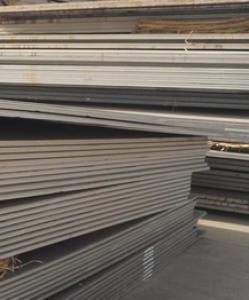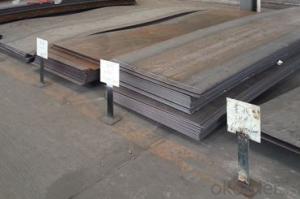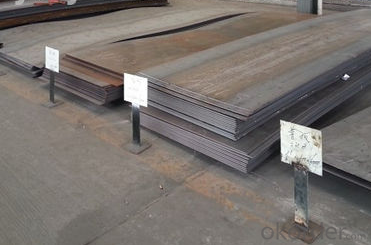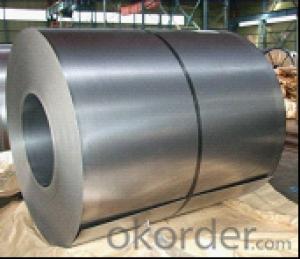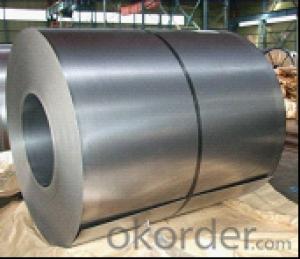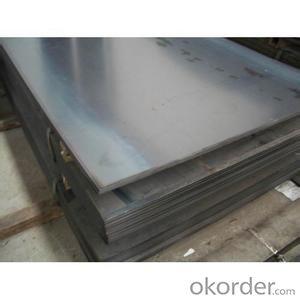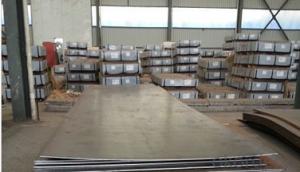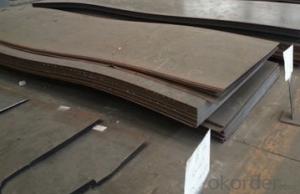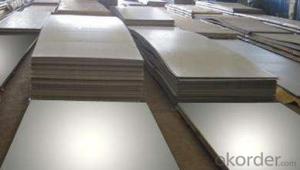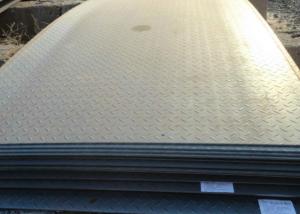Hot Rolled Carbon Steel Plate,Carbon Steel Sheet A573Gr.65CNBM
- Loading Port:
- Qingdao
- Payment Terms:
- TT OR LC
- Min Order Qty:
- 10 pc
- Supply Capability:
- 30 pc/month
OKorder Service Pledge
OKorder Financial Service
You Might Also Like
Quick Details
| Standard: | AISI, ASTM, GB, JIS | Grade: | Q195,Q235,Q345,A36,C45 | Thickness: | 1.0-30MM |
| Model Number: | Q235,Q195,Q345 | ||||
| Type: | Steel Plate | Technique: | Hot Rolled | Surface Treatment: | Coated |
| Application: | Ship Plate | Special Use: | Silicon Steel | Width: | 30-2000mm |
| Length: | as your requirement | standard: | hot rolled | Surface: | Anti-rust oil |
Packaging & Delivery
| Packaging Details: | seaworthy packages or as customers' require |
| Delivery Detail: | within 15 days after the advance payment |
Hot rolled steel plate
1 carbon steel plate 3mm thick General information
| Product name | Type | Specification | Implementation of GB | ||
| thick | wide | long | |||
| Carbon structural steel | Q195,Q215, Q235A,Q235B, Q235C,Q255, Q275 | 4-120 | 1500-4500 | 6000-12000 | GB/T700-2006 |
| Low-alloy structural steel | Q295,Q345A, Q345B,Q2345C | 4-120 | 1500-4500 | 6000-12000 | BG/T1591-1994 |
| Quality carbon structural stee | 30-50 | 4-120 | 1500-4500 | 6000-12000 | BG/T699-1999 |
| Ship steel | CCSA,CCSB | 4-120 | 1500-4500 | 6000-12000 | materials and welding condition |
| CCSAH32,CCSAH36 CCSDH32,CCSDH36 | 4-120 | 1500-4500 | 6000-12000 | materials and welding condition or GB 712-2000 | |
| Boiler steel | 20g,22Mng, 16Mng,19Mng | 4-120 | 1500-4500 | 6000-12000 | GB 713-1997 |
| Pressure vessel steel | 1622Mng,20R, 15MnVR,15MnVNR | 4-120 | 1500-2700 | 6000-12000 | GB 6654-1996 |
| European standard plate
| S235JR,S235J0, S275JR,S275J0, S275JR2,S355JR, S355J0,S355J2 | 4-120 | 1500-4500 | 6000-12000 | EN 10025 |
| Japanese standard plate | SS400,SS400-B | 4-120 | 1500-4500 | 6000-12000 | JIS G3101-2004 |
2 carbon steel plate 3mm thick detail specification
Material:
A283Gr.D/A573Gr.65,A516Gr65,A516Gr70,A284Gr.D
SS400,SS300,CCSB A36,A32,LRA32,LRB,Q235
Q195,Q235,Q345,SS400,ASTM A36,E235B
Thickness: 4mm-120mm
width: 1500mm-4500mm
Length:2-10m ,accordingly
Thickness | 4-120mm |
Width | 1500-4500mm or as custom's request |
Length | 2-12m,as your requirment |
Technique | Cold rolled or hot rolled |
Surface treatment | Bare, galvanized coated or as customer's requirements. |
Standard | ASTM,EN,GB,JIS,GB |
Material | A283Gr.D/A573Gr.65,A516Gr65,A516Gr70,A284Gr.D SS400,SS300,CCSB A36,A32,LRA32,LRB,Q235 Q195,Q235,Q345,SS400,ASTM A36,E235B |
Terms of Payment | L/C or T/T |
Chemical composition | C≤0.004%;Si≤0.030%; Mn ≤0.17%;P≤0.012%; S≤0.010%; Fe balance |
Delivery Detail | within 30days once receive deposite or confirm L/C |
Packing | Standard export packing,or as requirement |
3 carbon steel plate 3mm thick application:
construction,machinery manufacturing, container manufacturing, shipbuilding, bridge construction. Can also be used to manufacture a variety of containers, the furnace shell, furnace plate, bridge and vehicle static steel plate, low alloy steel plate,shipbuilding plate, boiler plate, pressure vessel plate, pattern plate, tractor parts, automobile frame steel plate and welding components
- Q: Can steel sheets be used for electrical grounding?
- Yes, steel sheets can be used for electrical grounding. Steel is a good conductor of electricity, and when properly connected to the grounding system, steel sheets can effectively dissipate electrical charges and provide a safe path for electrical current to flow into the ground.
- Q: Are steel sheets available in textured finishes?
- Yes, steel sheets are available in textured finishes. These finishes can include patterns such as diamond, linen, or leather grain, adding visual interest and enhancing the overall aesthetic appeal of the steel sheets.
- Q: What is the difference between a laminated and non-laminated steel sheet?
- A laminated steel sheet is formed by layering multiple thin sheets of steel together, while a non-laminated steel sheet is made from a single solid piece of steel. The lamination process enhances the strength and durability of the sheet, making it more resistant to bending, warping, and corrosion. On the other hand, non-laminated steel sheets are generally less expensive and may be easier to work with due to their uniform composition.
- Q: What are the different surface finishes for galvalume steel sheets?
- The different surface finishes for galvalume steel sheets include regular spangle, minimized spangle, and zero spangle. Regular spangle has a shiny, reflective surface, minimized spangle has a less noticeable spangle pattern, and zero spangle has a smooth, matte finish.
- Q: Can steel sheets be used for solar panel installations?
- Yes, steel sheets can be used for solar panel installations, particularly as a mounting structure or frame for the panels. Steel provides strength, durability, and stability, making it an ideal material for supporting solar panels and ensuring their long-term performance.
- Q: What does "Z" mean to the performance of steel?
- Hello, I do steel plate, Z to the performance, that is, the thickness of the direction of tension, if the steel plate is greater than 40Mm, the stress position of the steel plate thickness direction, then you have to Z performance! Don't forget the purchase list, brother. Contact information!
- Q: How do steel sheets compare to other materials like aluminum or copper?
- Steel sheets have several advantages over other materials like aluminum or copper. Firstly, steel is much stronger and more durable than both aluminum and copper. This makes steel sheets ideal for applications that require high strength and resistance to wear and tear, such as construction, automotive manufacturing, and industrial machinery. Secondly, steel sheets have a higher melting point than both aluminum and copper. This means that steel can withstand higher temperatures without deforming or melting, making it suitable for applications that involve exposure to high heat or fire. Additionally, steel sheets are more cost-effective than both aluminum and copper. Steel is widely available and relatively inexpensive compared to these other materials. This makes steel sheets a more economical choice for large-scale applications that require a significant amount of material. Furthermore, steel sheets have excellent corrosion resistance properties when properly coated or treated. Aluminum and copper, on the other hand, are more prone to corrosion and require additional protective measures. This makes steel sheets a better choice for outdoor or marine applications where exposure to moisture and harsh environments is a concern. Lastly, steel sheets are highly recyclable, making them a more sustainable choice compared to aluminum and copper. Steel is one of the most recycled materials in the world, with a recycling rate of nearly 90%. This reduces the environmental impact and conserves natural resources. In summary, steel sheets offer superior strength, durability, heat resistance, cost-effectiveness, corrosion resistance, and recyclability compared to materials like aluminum or copper. These qualities make steel sheets a versatile and reliable choice for a wide range of applications across various industries.
- Q: Can steel sheets be used in the telecommunications industry?
- Yes, steel sheets can be used in the telecommunications industry. Steel sheets are commonly used for various applications in the telecommunications industry due to their strength, durability, and ability to protect sensitive equipment. They are often used to manufacture communication towers, antenna mounts, equipment cabinets, and enclosures. Steel sheets provide structural support and can withstand harsh environmental conditions such as strong winds, extreme temperatures, and heavy loads. Additionally, steel sheets can be easily fabricated and customized to meet specific requirements, making them a popular choice in the telecommunications industry.
- Q: What are the applications of steel sheets in construction?
- Steel sheets have a wide range of applications in construction due to their exceptional strength, durability, and versatility. Some of the key applications of steel sheets in construction include: 1. Roofing and cladding: Steel sheets are commonly used for roofing and cladding in both residential and commercial buildings. They provide a weather-resistant and long-lasting solution, protecting the structure from the elements. 2. Structural components: Steel sheets are utilized in the construction of structural components like beams, columns, and trusses. The high strength-to-weight ratio of steel allows for the creation of lightweight yet robust structures that can withstand heavy loads and seismic forces. 3. Flooring: Steel sheets are often used as flooring material in industrial buildings, warehouses, and factories. Their smooth surface makes it easy to clean and maintain, while their strength and fire-resistant properties provide a safe working environment. 4. Wall partitions: Steel sheets are commonly employed in the construction of wall partitions due to their stability and sound insulation properties. They can easily be cut and shaped to fit any design, allowing for flexible and customizable partition layouts. 5. Ductwork and HVAC systems: Steel sheets are widely used in the fabrication of ductwork and HVAC systems. Their smooth and airtight surfaces allow for efficient air movement and regulation, ensuring proper ventilation and temperature control in buildings. 6. Reinforcement: Steel sheets are often integrated into concrete structures as reinforcement. This helps to enhance the strength and load-bearing capacity of the building, making it more resistant to bending, tension, and compression forces. 7. Safety and security: Steel sheets are utilized in the construction of safety and security features such as doors, gates, and window frames. Their high strength and resistance to impact and vandalism make them an ideal choice for ensuring the safety and protection of a building. In summary, steel sheets are extensively used in construction for roofing, cladding, structural components, flooring, wall partitions, ductwork, reinforcement, and safety features. Their superior strength, durability, and versatility make them an essential component in various construction applications, contributing to the overall safety, longevity, and functionality of buildings.
- Q: Can steel sheets be used for modular construction or prefabricated buildings?
- Yes, steel sheets can be used for modular construction or prefabricated buildings. Steel sheets offer high strength and durability, making them suitable for constructing modular or prefabricated buildings. They can be easily fabricated, assembled, and disassembled, allowing for efficient construction processes. Additionally, steel sheets provide excellent resistance to fire, pests, and extreme weather conditions, making them a popular choice for modular construction or prefabricated buildings.
Send your message to us
Hot Rolled Carbon Steel Plate,Carbon Steel Sheet A573Gr.65CNBM
- Loading Port:
- Qingdao
- Payment Terms:
- TT OR LC
- Min Order Qty:
- 10 pc
- Supply Capability:
- 30 pc/month
OKorder Service Pledge
OKorder Financial Service
Similar products
Hot products
Hot Searches
Related keywords

